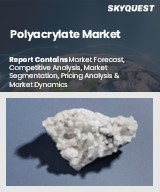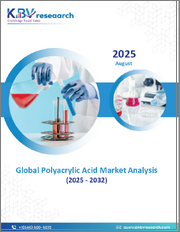
|
연간정보 서비스
상품코드
1225834
세계의 아크릴산 시장 분석 : 플랜트 생산능력, 생산, 운영 효율, 수요 및 공급, 최종사용자 업계, 판매채널, 지역 수요, 외국 무역, 기업 점유율(2015-2030년)Global Acrylic Acid Market Analysis: Plant Capacity, Production, Operating Efficiency, Demand & Supply, End-User Industries, Sales Channel, Regional Demand, Foreign Trade, Company Share, 2015-2030 |
||||||
세계의 아크릴산 시장 규모는 2021년 580만 톤에서 2030년까지 약 850만 톤에 달하며, 예측 기간 중 건전한 CAGR로 4.18%의 성장이 예측됩니다.
세계의 아크릴산 시장을 조사분석했으며, 시장의 개요, 부문별·지역별 분석, 기업 점유율 등의 정보를 정리하여 전해드립니다.
목차
제1장 생산능력 : 기업별
아크릴산의 중요한 제조업체와 현재 및 향후 운영 효율에 관한 최신 정보를 실시간으로 입수할 수 있다.
제2장 생산능력 : 로케이션별
제조업체 위치 기반 능력 분석에 의해 아크릴산의 지역 공급을 보다 깊게 이해한다.
제3장 생산 : 기업별
주요 기업에 의한 과거 아크릴산의 연간 생산량을 조사했으며, 향후 수년간 어떻게 성장하는지 예측한다.
제4장 수요 : 최종 용도별
어느 최종사용자 업계(아크릴산 에스테르, 고흡수성 폴리머, 수처리, 세제, 제지, 기타)가 시장을 형성하고 있는지, 아크릴산 시장의 성장 예측을 발견한다.
제5장 수요 : 지역별
북미, 유럽, 아시아태평양, 중동·아프리카, 남미 등의 다양한 지역에서 아크릴산의 수요 변화를 분석하고 지역의 수요 매핑을 지시한다.
제6장 수요 : 판매채널별(직접·간접)
아크릴산의 판매에는 복수 채널이 사용된다. 업계 판매의 대부분을 대리점 및 딜러 또는 직접 판매가 차지하고 있는지 아닌지 분석하는데 도움이 된다.
제7장 수급 격차
아크릴산의 무역흑자와 적자에 관한 정보를 얻기 위해 수급 격차를 결정한다.
제8장 기업 점유율
아크릴산의 시장 점유율 중 현재 전 세계의 주요 기업이 차지하는 비율을 파악한다.
제9장 수출 : 국가별
주요 국가의 아크릴산 수출량에 관한 상세를 취득한다.
제10장 수입 : 국가별
주요 국가의 아크릴산 수입량에 관한 상세를 취득한다.
KSA 23.03.13The global Acrylic Acid market demand stood at 5800 thousand tonnes in 2021 and is expected to grow at a healthy CAGR of 4.18% during the forecast period until 2030. Indian Oil Corporation Limited (IOCL) Acrylic Acid plant, expected to function in 2025, with capacity of 90 thousand tonnes in Gujarat. IOCL placed a contract worth USD 225 million on Tecnimont to implement this new acrylic acid unit.
Acrylic acid is an unsaturated hydrocarbon with the chemical formula CH2=CHCOOH. It is synthesized by catalytic oxidation of Propylene. In this process, two-stage selective oxidation of Propylene occurs to produce acrylic acid with Acrolein as the fast-acting intermediate. This reaction occurs in a fixed bed reactor along with a catalyst at a temperature between 310-2500 degrees Celsius. The catalysts such as Tantalum, Arsenic, and Molybdenum are used in this reaction. Acrylic acid is frequently utilized for the generation of polyacrylates by polymerization reaction.
Furthermore, Acrylic Acid serves as a monomer for various acrylic polymers, including polyacrylic and polymethacrylic acids. Major applications of acrylic acid are for the manufacturing of Acrylic Esters and Super Absorbent Polymer (SAP). Furthermore, the numerous industrial applications of acrylic acid and its derivatives and copolymers, are paints, coatings, adhesives, textiles, inks, and more.
The primary driver of the Acrylic Acid global market is the manufacturing of acrylate esters. Acrylate ester is widely employed for various applications such as paints & coatings, textiles, plastics, and adhesives. This is largely driven by the growth observed in the construction sector and global infrastructure projects propelling the overall acrylic acid market. In addition, increasing use of butyl acrylates, by coating application is expected to further expand the overall market. The Acrylic Acid global market is anticipated to swell up to approximately 8500 thousand tonnes by the forecast period of 2030.
Based on demand by region, the Asia Pacific dominates the Acrylic Acid market with 48% of the market share of global Acrylic Acid in 2021. The demand for Acrylate Ester for applications in the construction sector is expected to expand in the future due to the rapid economic growth of nations like China and India. Furthermore, the increase in demand for sanitary napkins and other personal hygiene products, is anticipated to swell up the demand for Super Absorbent Polymer, resulting in acceleration of the demand of Acrylic Acid in APAC. North America and Europe stand next in the line after Asia Pacific region. Asia Pacific is also leading as the producer of the global the Acrylic Acid market. In 2021, Asia Pacific contributed more than 50% of the global Acrylic Acid.
Based on the end-user industry, the global Acrylic Acid market is segmented into Acrylate Ester, Super Absorbent Polymer, Water Treatment, Detergent, Paper, and others. Among these industries, the Acrylate Ester sector dominates the Acrylic Acid market across the globe. This industry consumed about 40% of the Acrylic Acid in 2021 and is expected to maintain its position in the forecast period. Super Absorbent Polymer sector is also a prominent consumer of Acrylic Acid. Super Absorbent Polymer displays amazing absorption properties and finds application in multiple industries. The rise in demand for sanitary items and baby diapers with the increasing awareness regarding personal hygiene and other adult intimate products among people is expected to result in global Acrylic Acid market expansion in the forecast period.
Major players in the production of Global Acrylic Acid are Arkema SA, BASF SE, Nippon Shokubai Co. Ltd., LG Chem limited, The Dow Chemical Company, Jiangsu Jurong Chemical Co. Ltd, Zhejiang Satellite Petro Chemical Co. Ltd., BASF-YPC Company Limited, Wanhua Chemical Group Co. Ltd., Evonik Industries AG, and Shanghai Huayi Acrylic Acid Co., Ltd.
Years considered for this report:
Historical Period: 2015- 2021
Base Year: 2021
Estimated Year: 2022
Forecast Period: 2023-2030
Objective of the Study:
- To assess the demand-supply scenario of Acrylic Acid which covers production, demand, and supply of Acrylic Acid market in the globe.
- To analyse and forecast the market size of Acrylic Acid
- To classify and forecast Global Acrylic Acid market based on end-use and regional distribution.
- To examine competitive developments such as expansions, mergers & acquisitions, etc., of Acrylic Acid market in the globe.
To extract data for Global Acrylic Acid market, primary research surveys were conducted with Acrylic Acid manufacturers, suppliers, distributors, wholesalers and Traders. While interviewing, the respondents were also inquired about their competitors. Through this technique, ChemAnalyst was able to include manufacturers that could not be identified due to the limitations of secondary research. Moreover, ChemAnalyst analyzed various segments and projected a positive outlook for Global Acrylic Acid market over the coming years.
ChemAnalyst calculated Acrylic Acid demand in the globe by analyzing the historical data and demand forecast which was carried out considering the historical extraction and supply and demand of Acrylic Acid across the globe. ChemAnalyst sourced these values from industry experts, and company representatives and externally validated through analyzing historical sales data of respective manufacturers to arrive at the overall market size. Various secondary sources such as company websites, association reports, annual reports, etc., were also studied by ChemAnalyst.
Key Target Audience:
- Acrylic Acid manufacturers and other stakeholders
- Organizations, forums and alliances related to Acrylic Acid distribution
- Government bodies such as regulating authorities and policy makers
- Market research organizations and consulting companies
The study is useful in providing answers to several critical questions that are important for industry stakeholders such as Acrylic Acid manufacturers, customers and policy makers. The study would also help them to target the growing segments over the coming years (next two to five years), thereby aiding the stakeholders in taking investment decisions and facilitating their expansion.
Report Scope:
In this report, Global Acrylic Acid market has been segmented into following categories, in addition to the industry trends which have also been detailed below:
- Market, by End Use: Acrylate Ester, Super Absorbent Polymer, Water Treatment, Detergent, Paper, and others
- Market, by Sales Channel: Direct Sale and Indirect Sale
- Market, by Region: North America, Europe, Asia Pacific, Middle East and Africa, and South America.
Available Customizations:
With the given market data, ChemAnalyst offers customizations according to a company's specific needs.
Table of Contents
Table of Content
1. Capacity By Company
On our online platform, you can stay up to date with essential manufacturers and their current and future operation capacity on a practically real-time basis for Acrylic Acid.
2. Capacity By Location
To better understand the regional supply of Acrylic Acid by analyzing its manufacturers' location-based capacity.
3. Production By Company
Study the historical annual production of Acrylic Acid by the leading players and forecast how it will grow in the coming years.
4. Demand by End- Use
Discover which end-user industry (Acrylate Ester, Super Absorbent Polymer, Water Treatment, Detergent, Paper, and others) are creating a market and the forecast for the growth of the Acrylic Acid market.
5. Demand by Region
Analyzing the change in demand of Acrylic Acid in different regions, i.e., North America, Europe, Asia Pacific, Middle East and Africa, and South America, that can direct you in mapping the regional demand.
6. Demand by Sales Channel (Direct and Indirect)
Multiple channels are used to sell Acrylic Acid. Our sales channel will help in analyzing whether distributors and dealers or direct sales make up most of the industry's sales.
7. Demand-Supply Gap
Determine the supply-demand gap to gain information about the trade surplus or deficiency of Acrylic Acid.
8. Company Share
Figure out what proportion of the market share of Acrylic Acid is currently held by leading players across the globe.
9. Country-wise Export
Get details about quantity of Acrylic Acid exported by major countries.
10. Country-wise Import
Get details about quantity of Acrylic Acid imported by major countries.
(주말 및 공휴일 제외)


















